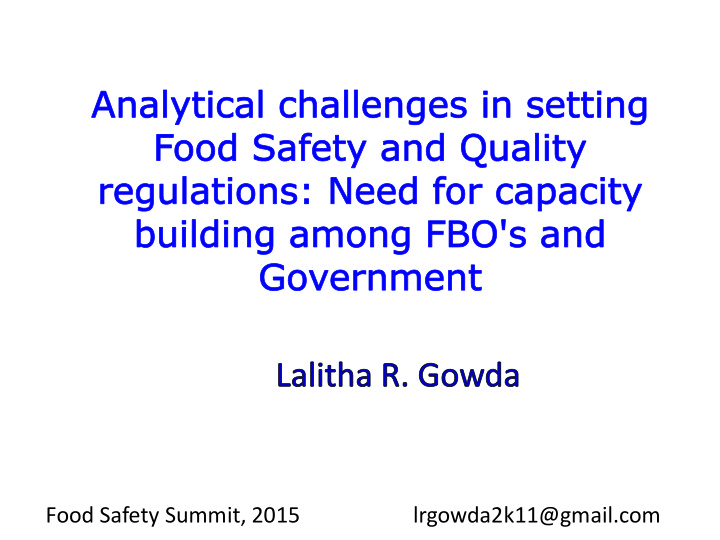



Food Safety Summit, 2015 lrgowda2k11@gmail.com
Foo ood and nd th the Con onsumer umer Is Food Safe? Is Food Available? Pathogens Accessible? Toxins Affordable? Contaminants Food Security Allergens Is Food Authentic? Meat species Fish species Where did the food Plant species come from? Ingredients Country How was food produced ? Locality - provenance Animal welfare Environmental Organic Fair Trade Ethics
Which species? Irradiation? Does it contain Heavy metals What is the age of the meat Does it contain vet drug residues Does it contain Is it Halal added gelatin /Kosher? Is it reconstituted Is it cloned? meat Is it PDO Does it contain /PGI added water Which country Does it contain does it come from? Is it fresh or frozen chemical or thawed meat contaminants/path ogens
Free Amino acids SIRMS Pollen Water Carbohydrates activity Volatile components Trace elements Sensory DNA sequencing pH
Consumers demand for Consumers demand for imported seasonal processed food: Ready- products to be to-eat, High in quality, available all year- Low in cost round A long food chain: Food is sourced globally tracking and control of and international trade quality and safety of is substantial raw materials requires reliable food analysis
Primary Storage Processing Packaging Distribution Retail Consum Produce ption
Food Testing Tool Box
1. In-House Industry Laboratory Food Producers/Processors • Due diligence 2. Government Laboratory State, National Referral Labs • For public health/consumer protection 3. Contract Testing Laboratory Independent testing • laboratory Offers services as a business • 4. University/Research Laboratory Conducts research •
.
Laboratory Services
QM
A method’s performance is defined by a number of important individual characteristics. Sensitivity Precision Repeatability. Reproducibility Accuracy Limit of Detection (LoD) Limit of Determination Bias Selectivity Linear Range Dynamic range Ruggedness, Robustness
FBOs Academia Government LABS How ?
• Involve all stakeholders: Government regulators, FBOs, academia and private laboratories/Instrument to define the criteria to establish fit-for-purpose methods of analysis. Develop SMPRs, SLV, MLV, with identified Working Groups and Expert Review Panels • Public-private partnership between Government regulators, FBOs, academia and private laboratories/Instrument to provide technical assistance to scientists involved in food safety testing through education to develop best practice testing methodologies and deliver fit-for-purpose methods of analysis. To lead an inspiring training program that will improve food safety laboratory testing
• Ready to use for Microbiology, food chemistry, and pesticide residue , heavy metal testing etc. Can be used to address a nonconformance, additional method validation, internal purpose and also any regulatory dispute.
Recommend
More recommend